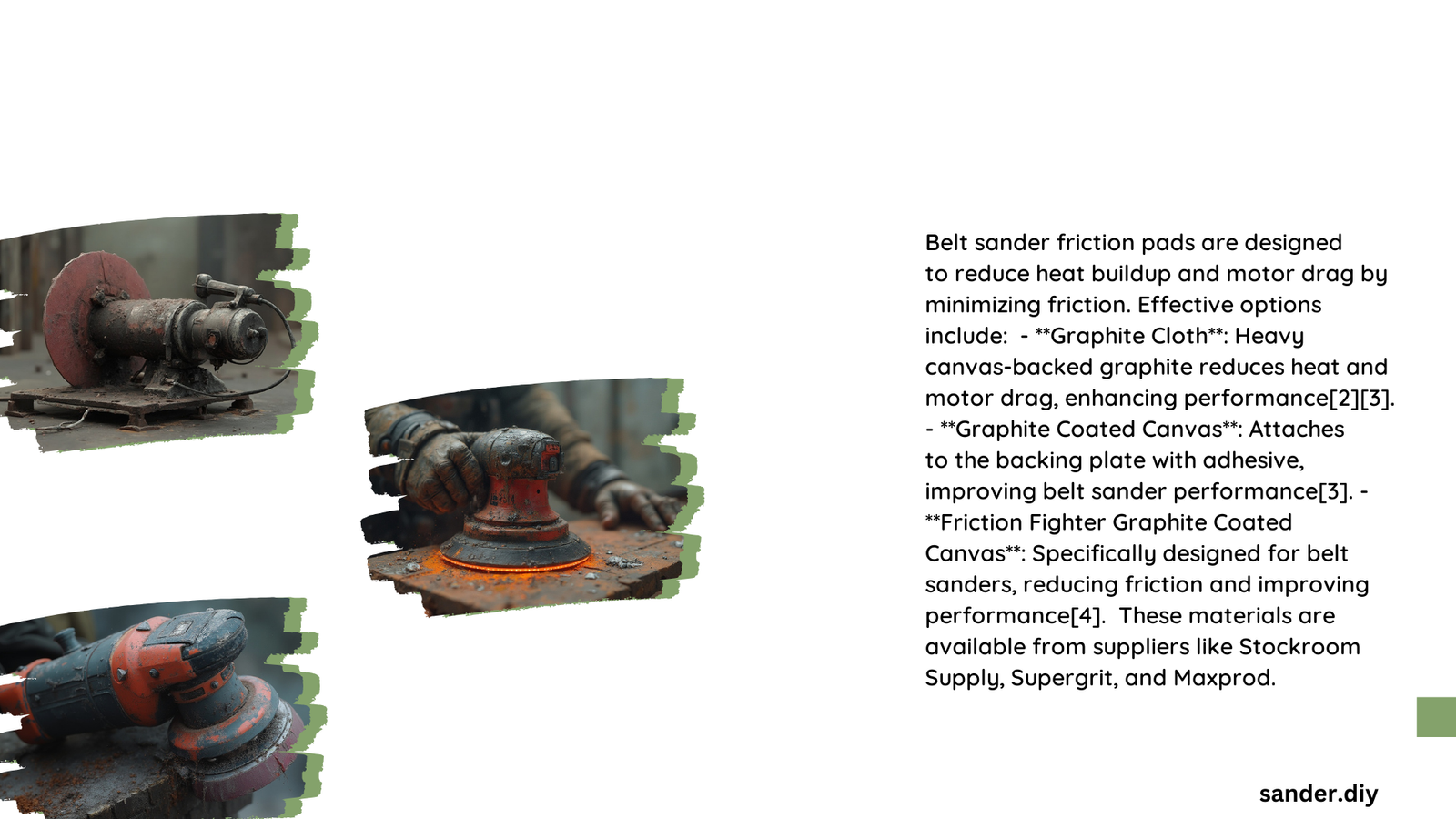Belt sander friction pads are crucial components that ensure smooth operation and longevity of belt sanders. These pads, typically made of graphite, provide a low-friction surface for the sanding belt to glide over, reducing heat buildup and wear. Understanding the dimensions, materials, replacement options, and costs associated with these pads is essential for maintaining your belt sander’s performance and efficiency.
What Are the Key Dimensions of Belt Sander Friction Pads?
The dimensions of belt sander friction pads vary depending on the specific model of the sander. For example, the Makita 9924DB Belt Sander uses a graphite pad with the following dimensions:
- Length: 7 inches (18 cm)
- Width: 3.9 inches (10 cm)
- Thickness: 0.07 inches (0.2 cm)
These precise measurements are crucial for ensuring a proper fit when replacing the pad. Using a pad with incorrect dimensions can lead to:
- Misalignment of the sanding belt
- Uneven wear on the belt
- Reduced sanding efficiency
- Potential damage to the sander or workpiece
What Materials Are Used in Belt Sander Friction Pads?

Belt sander friction pads are primarily made from graphite due to its excellent properties:
- Low friction coefficient
- High heat dissipation
- Durability and wear resistance
- Smooth, consistent surface
The use of graphite offers several advantages:
- Reduced heat buildup during operation
- Extended lifespan of both the pad and the sanding belt
- Smooth operation, resulting in better finish quality
- Minimal maintenance requirements
How Long Do Belt Sander Friction Pads Last?
The lifespan of a belt sander friction pad depends on several factors:
- Frequency of use
- Type of materials being sanded
- Pressure applied during sanding
- Quality of the pad
Under typical usage conditions, a high-quality graphite friction pad can last:
- Several months to a year for regular DIY use
- 3-6 months for frequent professional use
It’s important to inspect the pad regularly for signs of wear or damage, such as:
- Visible grooves or indentations
- Uneven surface
- Cracking or chipping
Replacing the pad promptly when these signs appear will help maintain optimal sander performance and prevent damage to the tool or workpiece.
What Are the Replacement Options for Belt Sander Friction Pads?
When it’s time to replace your belt sander friction pad, you have several options:
- OEM (Original Equipment Manufacturer) parts
- Aftermarket replacements
- Generic graphite sheets (cut to size)
Here’s a comparison of these options:
| Option | Pros | Cons |
|---|---|---|
| OEM parts | Perfect fit, high quality | More expensive |
| Aftermarket replacements | Often cheaper, good quality | May not fit as perfectly |
| Generic graphite sheets | Most economical, customizable | Requires cutting, may not be ideal thickness |
For Makita belt sanders, the part number for the replacement graphite pad compatible with the 9924DB model is 423036-6. This ensures you get the correct size and quality for your specific sander.
How Much Do Belt Sander Friction Pads Cost?
The cost of belt sander friction pads can vary based on several factors:
- Brand (OEM vs. aftermarket)
- Quality of materials
- Quantity purchased (individual vs. bulk)
Here’s a general price range for belt sander friction pads:
- Individual OEM pads: $10 – $20
- Aftermarket replacements: $8 – $15
- Generic graphite sheets: $5 – $10 per sheet (may yield multiple pads)
Buying in bulk can often reduce the cost per unit, especially for professional users or workshops that go through pads more quickly.
How to Install a New Belt Sander Friction Pad?
Installing a new belt sander friction pad is generally a straightforward process:
- Unplug the sander for safety
- Remove the sanding belt
- Locate the screws or fasteners holding the old pad in place
- Carefully remove the old pad
- Clean the surface where the pad sits
- Place the new pad, ensuring proper alignment
- Secure the new pad with the screws or fasteners
- Reinstall the sanding belt
Key points to remember during installation:
- Ensure the new pad is the correct size and thickness
- Align the pad properly to prevent belt misalignment
- Tighten fasteners securely, but avoid over-tightening
What Are the Signs That a Belt Sander Friction Pad Needs Replacement?
Recognizing when to replace your belt sander friction pad is crucial for maintaining optimal performance. Look out for these signs:
- Visible wear or grooves on the pad surface
- Uneven sanding results
- Increased heat buildup during operation
- Unusual noise or vibration while sanding
- Difficulty in keeping the sanding belt aligned
Regular inspection of the friction pad can help catch these issues early, preventing potential damage to your sander or workpiece.
How to Extend the Life of Your Belt Sander Friction Pad?
To maximize the lifespan of your belt sander friction pad:
- Use appropriate pressure when sanding
- Keep the sander clean and free from dust buildup
- Store the sander properly when not in use
- Use the correct grit and type of sanding belt for each job
- Avoid overheating the sander by taking breaks during extended use
By following these tips, you can ensure that your belt sander friction pad lasts longer and performs optimally throughout its lifespan.
In conclusion, understanding the importance of belt sander friction pads and how to maintain them is crucial for anyone who regularly uses a belt sander. By choosing the right pad, replacing it when necessary, and following proper maintenance procedures, you can ensure your belt sander operates efficiently and produces high-quality results for years to come.
References:
1. https://www.kmstools.com/makita-graphite-plate.html
2. https://thetoolstore.ca/products/makita-423036-6-replacement-graphite-pad-for-9924db-belt-sander
3. https://www.toolcraft.co.za/products/makita-graphite-friction-pad-9401-1pc
